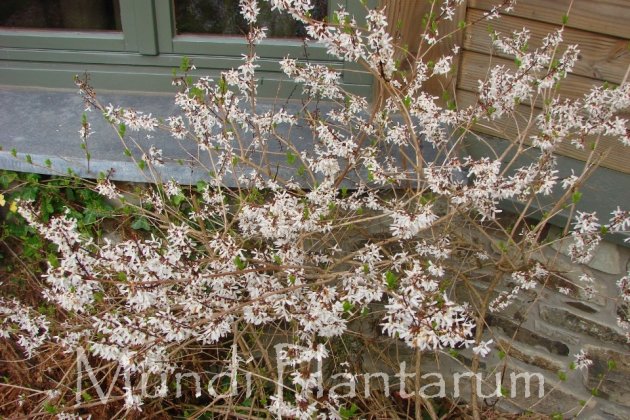Shrub of Korean origin with spherical port and arched branches. Called white forsythia due to its white flowers from February to April before the leaves. Height 1,5m.
Abeliophyllum distichum
Famille:
Oleaceae
Classification
Trees and shrubs
Climat
Zone 7: from -17°C to -12°C
Couleur de feuille
- Green
Couleur de fleur
- White
Exposition
- Sheltered winds
- Sunny
- Part shade
Taille
150 to 200cm
1 to 2m
Intérêts remarquables
- Flower
- Perfume
Plante intéressante
- In spring
Type de sol
- Neutral
Utilisation au jardin
- Massif
- Parterre
GENERAL DESCRIPTION
- ORIGIN: Korea, introduced in 1924.
- CLIMATE: Resistant to -15 ° C. Requires a protections the first years against the cold.
- EXPOSURE: Full sun and warm place, protect from winds, against a warm wall.
- SOIL: Ordinary, well drained. Not too dry and cool.
- GROWTH: Slow.
- PATHOLOGY: No known disease.
- MULTIPLICATION: By mid-August cuttings in July or by hardwood cuttings in October.
- PRUNING: After blooming, prune all branches to 1/4 of their length, over a vigorous bud, to force the plant to reform new shoots near the base.
GENERAL PHYSIOLOGY
- DIMENSIONS: Height from 1m to 2m.
- HABIT: Arched shrub, can be guided as climbing.
- TRUNK: Multi stems.
- BRANCHES: Flexible and strongly arched.
LEAVES PHYSIOLOGY
- SHAPE: Simple, opposite, whole, oval, 5 to 7cm long.
- COLOR: Green, sometimes purple in autumn.
- NOTE: Caduque, similar to that of the Abelia. They appear after the leaves.
FLOWERS PHYSIOLOGY
- TIME: Winter flowering from February to April, depending on the region. The flowers appear before the leaves.
- FORM: Simple flowers with 4 soft petals, abundant all around the branches.
- COLOR: White, green button.
- NOTE: Perfumed.
FRUITS PHYSIOLOGY
- SHAPE: Spherical samare with a single seed.
- COLOR: Green, sometimes pink in the center, then brown.
- SEEDS: Round and flat, single in a fruit.
